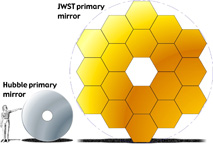With its Wide Field Planetary Camera 2, Near Infrared Camera Multi-Object Spectrograph (NICMOS), and Fine Guidance Sensors still operational, the Hubble Space Telescope isn’t exactly blind. But the loss of the Advanced Camera for Surveys would be a serious one, and the bad news is that the next servicing mission, scheduled for mid-2008, probably won’t be able to fix the problem. ACS lived out its five year operational life but dazzling vistas like the Ultra Deep Field make us yearn for more.
Hubble’s other instruments are still doing good science. Recall that the UDF itself is actually made up of images from the ACS and NICMOS, leading Centauri Dreams to believe that many observational programs will go forward after adjusting to the change in instrumentation. As always, we make a virtue of necessity, a phrase first recorded by Chaucer that resonates even now in the realm of deep space exploration.
Meanwhile, we receive more positive news from the testing of the James Webb Space Telescope’s backplane (its ‘spine’), which supports the mirrors of the telescope and has been pronounced fit by project engineers. A recent freezing test took place at Marshall Space Flight Center in Huntsville, checking down to the nanometer level to ensure that the backplane will hold steady during space observations. Testing down to 30 degrees Kelvin (-405 degrees Fahrenheit) has already taken place, a step toward shaking out all the telescope’s key technologies.

A few points of comparison between JWST and Hubble: The JWST will do most of its work at infrared wavelengths. Hubble can do some infrared work as well, but its primary mission is at optical and ultraviolet wavelengths. As to light gathering surface, JWST really is Hubble’s successor. Its 6.6 meter primary mirror significantly upgrades Hubble’s 2.4 meter one; in fact, JWST boasts about seven times the collecting area. And as compared to the Spitzer Space Telescope, which also works in the infrared, JWST offers much higher resolution. Finally, Hubble is in a near-Earth orbit, whereas JWST will operate 1.5 million miles out at the L2 point, using its huge solar shield to block sunlight and stay cool.
Image: Hubble and JWST’s primary mirrors compared. Credit: NASA/MSFC.


Hi Paul
The simulated visual acuity of the JWST in your last post is incredible. Will make watching planets form a major research activity with a torrent of data to work with. I just hope the Deep Space astronomers don’t monopolise the JWST’s time.
Lots of good exoplanetary science ahead for JWST, let’s assume. But you’re right, Adam, observing time is going to be tough to come by. The lines are already forming…
You’re entirely right. It seems promising, indeed! I don’t wish to start any debate, but it seems like since we have the JWST coming, it would be OK if we allowed Hubble to die out after all. Or perhaps I’m being rather harsh towards Hubble?
The World Space Observatory (WSO-UV) – Current status
Authors: Michela Uslenghi (1), Isabella Pagano (2), Cristian Pontoni (2), Salvatore Scuderi (2), Boris Shustov (3) ((1) INAF/IASF-Milano, (2) INAF/Catania Astrophysical Observatory, (3) INASAN, Moscow)
(Submitted on 14 Jan 2008)
Abstract: This paper reports on the current status of the World Space Observatory WSO-UV, a space mission for UV astronomy, planned for launch at the beginning of next decade. It is based on a 1.7 m telescope, with focal plane instruments including high resolution spectrographs, long slit low resolution spectrographs and imaging cameras.
Comments: 6 pages, 5 figures; Chinese Journal for Astronomy and Astrophysics (ChJAA), in press. Invited talk at the Frascati Workshop 2007 Vulcano (Italy), May 28 – June 2 “Multifrequency Behaviour Of High Energy Cosmic Sources”
Subjects: Astrophysics (astro-ph)
Cite as: arXiv:0801.2080v1 [astro-ph]
Submission history
From: Michela Uslenghi [view email]
[v1] Mon, 14 Jan 2008 17:04:03 GMT (1714kb)
http://arxiv.org/abs/0801.2080
The Universe in a Mirror
The Saga of the Hubble Space Telescope and the Visionaries Who Built It
Robert Zimmerman
To read the entire book description or a sample chapter, please visit:
http://press.princeton.edu/titles/8618.html
The Hubble Space Telescope has produced the most stunning images of the cosmos humanity has ever seen. It has transformed our understanding of the universe around us, revealing new information about its age and evolution, the life cycle of stars, and the very existence of black holes, among other startling discoveries. The Universe in a Mirror tells the story of this telescope and the visionaries responsible for its extraordinary accomplishments.
Review: The Universe in a Mirror
The Hubble Space Telescope has survived a long series of
technical and programmatic challenges to become perhaps
the most revered telescope or spacecraft in history.
Jeff Foust reviews a book that provides a new history of
the space telescope and its place in astronomy.
http://www.thespacereview.com/article/1143/1
Saving Hubble on NOVA’s ScienceNOW on PBS-TV
Two teams of spacewalkers take on the risky mission of reviving
the ailing Space Telescope.
http://www.pbs.org/wgbh/nova/sciencenow/0303/01.html
March 19, 2009
JWST Will Provide Capability to Search for Biomarkers on Earth-like Worlds
Written by Nancy Atkinson
Does another Earth exist somewhere in our galaxy? With the recent lauch of the Kepler spacecraft, astronomers are getting closer and closer to finding an Earth-sized planet in an Earth-like orbit.
But once that search succeeds, the next questions driving research will be: Is that planet habitable? Does it have an Earth-like atmosphere? Answering those questions will not be easy.
But the telescope up for the task is the James Webb Space Telescope (JWST), set for a planned launch in 2013.
Two researchers recently examined the ability of JWST to characterize the atmospheres of hypothetical Earth-like planets, and found this is the telescope that would be able to detect certain gases called biomarkers, such as ozone and methane, for close Earth-size worlds.
See our related article: Q&A with Dr. John Mather on JWST.
http://www.universetoday.com/2009/03/19/jwst-will-provide-capability-to-search-for-biomarkers-on-earth-like-worlds/